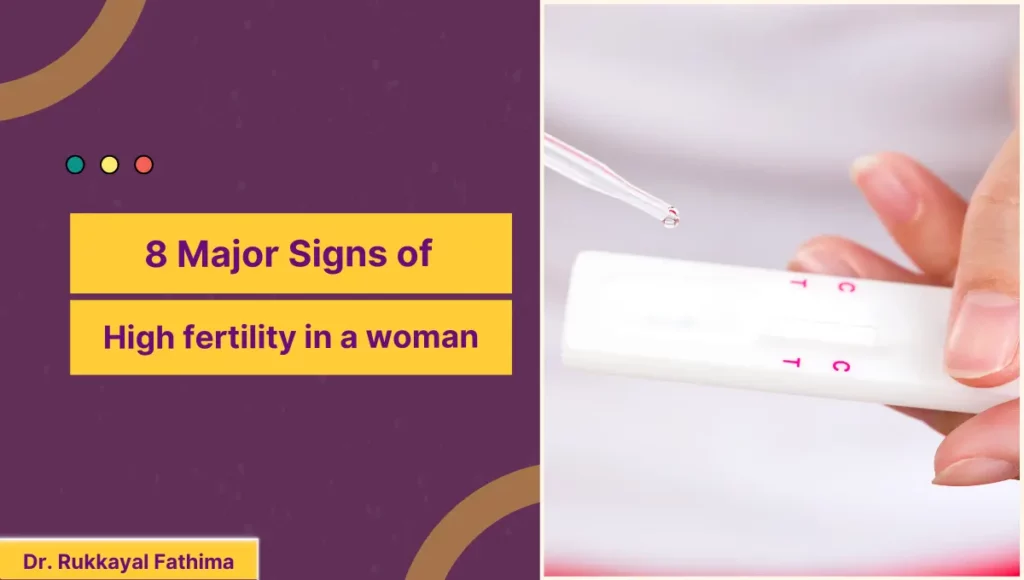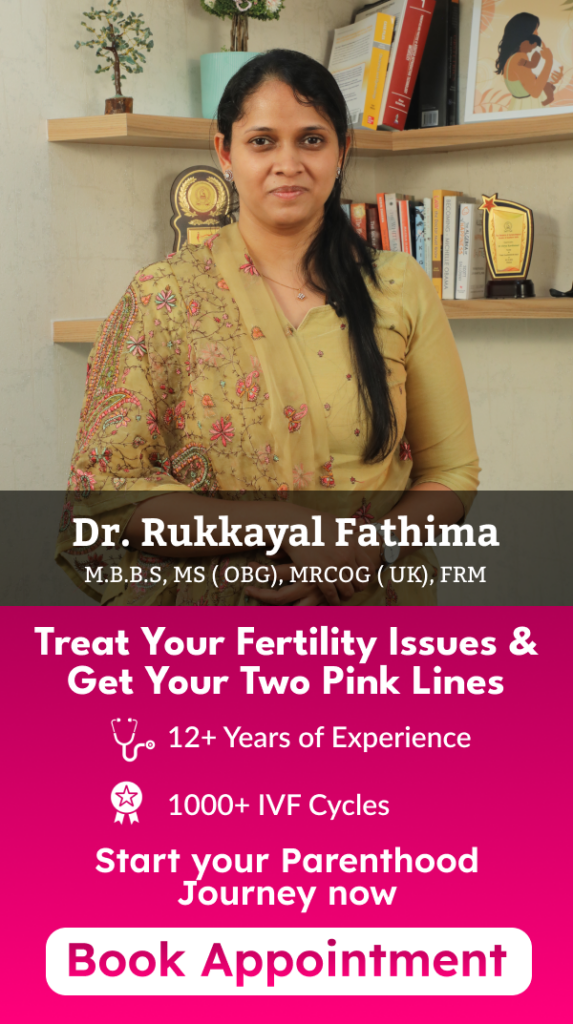Signs of high fertility in a woman
It is essential for women who are trying to conceive a child to be familiar with the signs of high fertility in a woman, so that they can have an accurate picture of their chances of achieving their goal of becoming pregnant.
The following is a list of some of the signs that a woman has a high fertility level:
Sign #1: A Positive Result from Your Ovulation Predictor
Test strips known as ovulation predictor kits determine when the body experiences an increase in luteinizing hormone (LH), which causes the egg to be released from the ovary.
An ovulation prediction kit with a positive result indicates that you should ovulate in the next 36 hours. The day of the LH surge and the two days after are ideal for having sex.
Sign #2: Changes in cervical mucus
Nevertheless, as ovulation approaches, your body begins to create more estrogen, which makes your cervix swell. Your cervical discharge may appear sticky, hazy, or scarce if not ovulating.
Cervical mucus turns transparent and supple, much like egg whites. Consider any variations in your discharge as a potential indicator of fertility because this change in discharge makes it easier for sperm to reach the egg.
Sign #3: Increased Sex Drive
Your sexual desire will increase due to an increase in hormones such as estrogen and testosterone just before your fertile window, which is the time right before ovulation.
Mother Nature is pretty smart about these things. During this time, not only will your sexual drive kick into high gear, but your body will also undergo subtle changes that will make you feel sexier and make your partner feel more drawn to you.
During this time, your sex drive will shift into high gear. These changes may include slightly fuller lips, a higher-pitched voice, a change in the structure of your face, and a change in how you walk and your hips move.
Sign #4: Increased Sense of Smell
It was discovered that women’s sense of smell becomes more acute as they get closer to the time of ovulation and that during this time, they are especially sensitive to smoky odors as well as male pheromones like androsterone.
This heightened sense of smell may be nature’s way of assisting women in selecting a suitable partner, although the exact reason for this is unknown.
Sign #5: Lower Abdominal Pain
It can last anywhere from a few minutes to several hours during a woman’s cycle and is a fertility symptom. Not all women feel this discomfort every month, but it can be a clue that ovulation is happening.
It is crucial to remember that not all women get these cramps every month, and it is acceptable never to get them.
Sign #6: Change in your Cervical Position
The process of labor and childbirth involves the cervix, the uppermost part of the vagina, and is what dilates.
It goes through various transitions during the menstrual cycle, but right before ovulation, it tends to become higher, softer, and more open. It is possible to self-check the cervix; however, it may take some practice to become proficient in the procedure.
Sign #7: Breast Tenderness
The hormone progesterone, which your body generates shortly after ovulation, causes sore breasts. This can be a comforting indication of fertility since it can signify that ovulation occurred that month.
Sign #8: Mid-Cycle Spotting
Because estrogen levels drop significantly after the egg is released, spotting in the middle of the cycle may indicate that you have recently ovulated. This temporary drop in estrogen levels might result in some spotting during the middle of your cycle, but it will usually go away within a day or two.
On the other hand, some women may have regular ovulation but never notice the spotting that occurs in the middle of their cycles.
Tests for fertility in women

There are several indicators of a woman’s fertility, as well as certain tests that medical professionals can perform to determine whether or not a woman is capable of bearing children. Examples include:
1. HSG or Hysterosalpingography
The HSG scan checks for fallopian tube obstructions and evaluates the uterus condition. If the fluid flows freely, assuming the fallopian tubes are unblocked is safe.
2. Ultrasound
Doing ovulation studies, evaluating the existence of uterine and ovarian illnesses, and looking for minute details are all done using ultrasound. Advanced techniques like TVS and saline infusion sonography are also applied.
3. Hormonal tests
A woman’s fertility rate can be determined by urine or blood tests for hormones like FSH, LH, and progesterone.
4. Laparoscopy
Laparoscopy is a minimally invasive procedure used to look for complications such as endometriosis and problems with the uterus, ovaries, and fallopian tubes. This procedure can also be used to treat endometriosis. Additionally, it can be utilized in simultaneously diagnosing and treating the condition.
5. Hysteroscopy
A thin tube called a hysteroscope is inserted through the vagina as part of the hysteroscopy procedure, which examines the uterus, ovaries, and fallopian tubes for abnormalities. It also allows the practitioner to remove a small portion of the organ, which makes it possible to sample the tissue.
Ways to promote fertility in women
The most crucial concept is that there are numerous strategies to increase female fertility, including enhancing the reproductive system:
1. Keeping a healthy weight is crucial for reproductive health because obesity can cause irregular periods and decreased fertility.
2. To increase the likelihood of conception, avoiding stress and obtaining enough sleep is critical. Stress can have a negative impact on female fertility.
3. Medications, including birth control pills, seizures, and thyroid conditions, should all be considered to ensure they are safe for reproductive health.
4. Women should eat more proteins, antioxidants, and multivitamins to increase fertility. They should also eat regularly and properly in the morning to lower their insulin levels.
Wrap up
Several factors, including a healthy reproductive system, can indicate a woman’s high fertility. When considering pregnancy, a woman aware of these signs may find that the process goes much more smoothly.
In addition, it is always best to conduct an internal assessment of one’s level of fertility before adversity comes knocking on the door. Even though the vast majority of fertile women exhibit these signs, there is still a chance that some women will not exhibit or observe the aforementioned physical changes (besides regular menses and hormonal balance).
When a woman’s signs of good fertility are either absent or difficult to understand, she needs to reach out a Fertility professional. Concerning one’s reproductive health, it is generally recommended that one does not avoid complications or incorrect signals.
Frequently Asked Questions
After a woman reaches reproductive age, she starts to show fertility indicators. Your chances of getting pregnant are significantly increased if you have regular periods without any troubles, are the correct weight, do not smoke or drink, do not have a hormone imbalance, do not have a pelvic infection, and do not have issues like ovulation disorder.
Ovulation, which is the monthly release of an egg to be fertilized by the sperm, is indicated by regular menstruation. This could indicate a woman is highly fertile. Hence, when a woman menstruates regularly, her chances of getting pregnant are higher.
If a woman organizes sexual activity for the high ovulation days, her chances of getting pregnant increase. The crucial six days, or five days right before ovulation and the day of ovulation, are when fertility is at its peak.
The three most fertile days of the month are the two days before ovulation and the third day, the actual day of ovulation. The greatest three days of the month to have sex if you’re trying to have a kid are these three days.
The five days leading up to and the day an egg is released from the ovary (ovulation) are called the “fertile window.” The optimum time to get pregnant is to engage in sexual activity.





